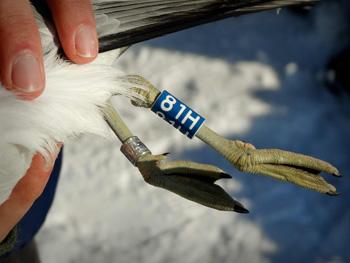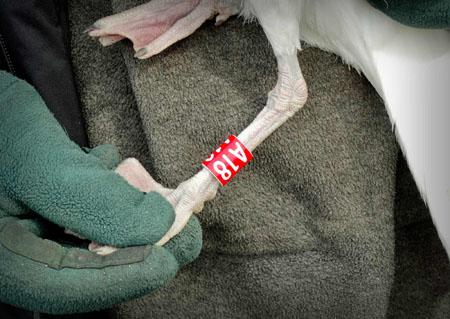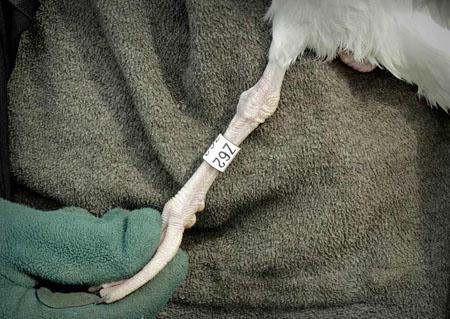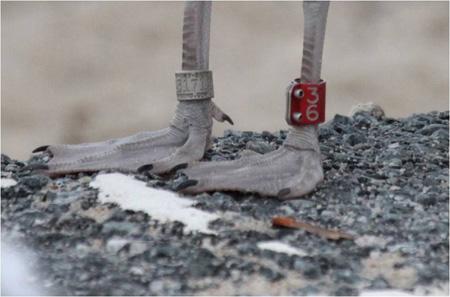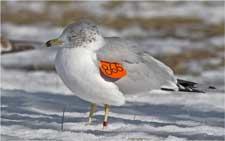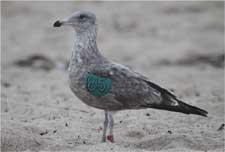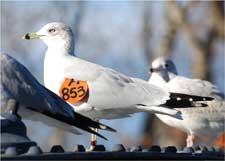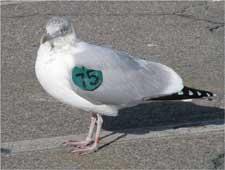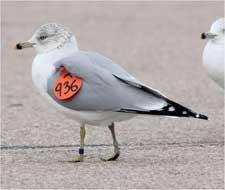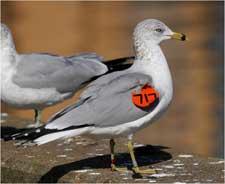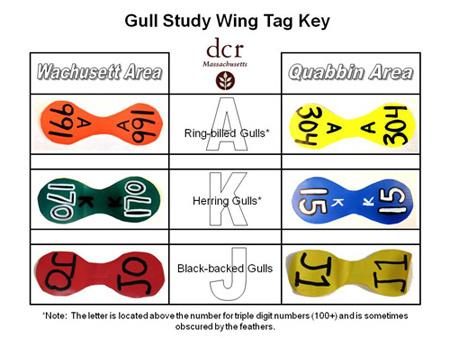2013 Update
DCR has wrapped up the first part of its study on the movements, feeding and site fidelity of wintering gulls in Massachusetts and has begun the next important chapter. DCR started working in 2012 with the Massachusetts Institute of Technology’s (MIT) Runstadler Lab to survey gulls for Avian Influenza (commonly known as bird flu). There is a wide range of species that can carry the virus, including humans. Wild waterbird species, like gulls, are considered a natural reservoir for the virus.
One important change to highlight is that starting in the fall of 2013 DCR is no longer placing patagial (wing) tags on the gulls we capture. Instead, standard plastic colored leg bands will be used on the left leg of the gull (see photo below). We would still like to know the whereabouts of the previously tagged gulls, so please continue to report sighting of both the patagial tagged gulls as well as the newly color banded gulls.
Overview
A variety of birds use the Wachusett and Quabbin Reservoirs for breeding, migratory stops, roosting, and feeding. Most species, like the common loon, occur in such low numbers that they don't pose a threat to water quality. However, some species – such as gulls, ducks and geese – can concentrate in large numbers for an extended period of time. DCR has a highly effective gull harassment program at both reservoirs to limit the pollutants from these birds.
As part of the gull control program, DCR is conducting research on the movements and behaviors of three species of gulls that roost nightly on Wachusett and Quabbin Reservoirs: ring-billed, herring, and great black-backed gulls.
This research program is designed to address the following questions:
- What and where are the seasonal food resources for each gull species?
- What are the movement patterns between feeding, loafing and roosting sites?
- Do they move between the DCR water supply reservoirs and “alternate roosts”?
- What are the population dynamics of gulls in Massachusetts?
a. Where do they nest?
b. What are the sources of mortality?
c. What is their lifespan?
If you have wing-tag information, please contact:
Ken MacKenzie
(508) 792-7423 ext.313
or
Dan Clark
(508) 792-7423 ext.215
Additional Resources
Banding and Tagging
Initial trapping was conducted throughout January, February, and March 2008, using three methods:
- A walk-in nest trap
- Steele’s net
- A rocket net
All methods successfully captured the targeted species, although the rocket net and Steele’s net were worked better. Starting in the fall of 2008, a net launcher and net gun were exclusively used for trapping.
Following capture, all birds are fitted with an aluminum federal leg band. A uniquely numbered colored leg band is placed on the opposite leg of all birds. During the first part of the study, most birds had a colored, uniquely numbered wing-tag attached to each wing. These wing-tags make long-distance identification possible, particularly when it is hard to see or read the leg bands. Wing-tags are color-coded based on the capture site’s proximity to either Wachusett or Quabbin Reservoir.
Tracking Gulls Via Satellite
A small number of gulls are fitted with satellite transmitters instead of wing-tags. Several types of transmitters have been deployed:
- A 45-gram GPS equipped transmitter on the adult great black-back gull
- 30-gram and 22-gram GPS equipped transmitters on adult herring gulls
- A 20-gram non-GPS equipped satellite transmitters on herring gulls
- A 9.5-gram non-GPS equipped satellite transmitter for the ring-billed gulls
All transmitters are solar-powered and have the potential to last several years. There are currently satellite transmitters on 5 ring-billed gulls, 9 herring gulls, and 1 black-back gull.
How the Public Can Help
You can help with this study. If you see a wing-tagged bird, please try to obtain the alpha-numeric combination on the tag (e.g., A57) and report it using the contact information below. Wing-tags can be seen from a distance, and the numbers on the tags are easily read with binoculars or sometimes even with the naked eye. Common places to find these wintering gull species are at landfills, parking lots, and ball fields. Please keep a look out for any wing-tagged birds. DCR will be happy to provide you with capture information about a specific bird. Reports on the project, when available, will be posted on this website.
Plastic Colored Leg Bands
